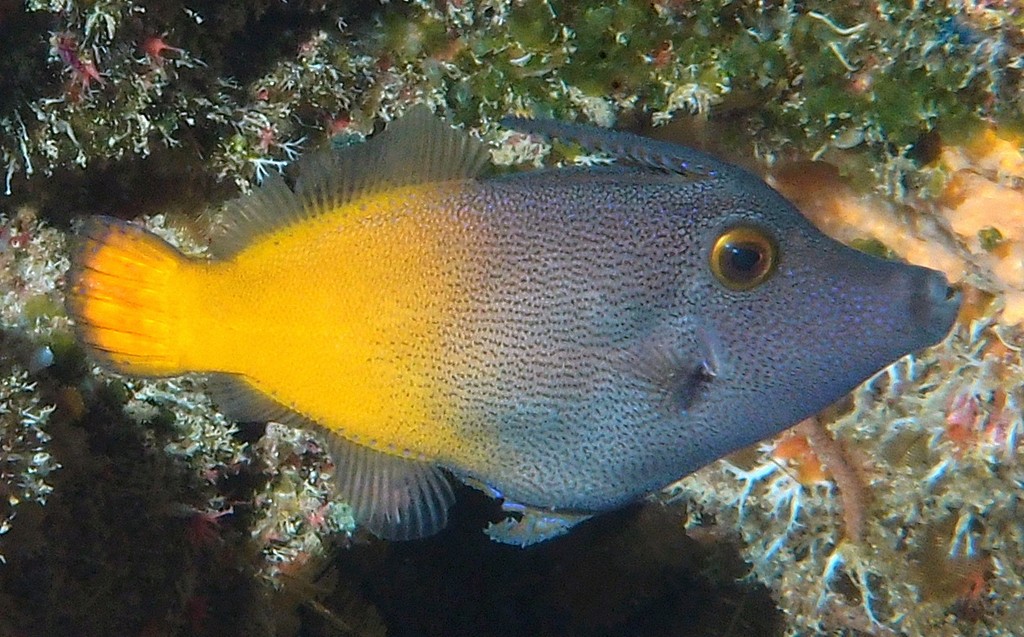PERVAGOR ASPRICAUDUS - (HOLLARD, 1854)
Actinopterygii (Gigaclass) > Actinopteri (Class) > Teleostei (Subclass) > Tetraodontiformes (Order) > Balistoidei (Suborder) > Monacanthidae (Family) > Pervagor (Genus)
Poisson-lime à queue orange, Lacefin filefish, Orangetail filefish, Orange-Tailed Leatherjacket, Orangetail leatherjacket, Yellowtail filefish, Johnston Nishikikawa Hagi, ジョンストンニシキカワハギ, 红尾炮弹, 粗尾前角鲀, 约翰斯顿前角鲀,
Synonymes
Monacanthus aspricaudus (Hollard, 1854)
Monacanthus rubricauda (Bliss, 1883)
Pervagor melanocephalus johnstonensis (Woods, 1966)
-------------------------
Description
Dorsal spines (total): 2; Dorsal soft rays (total): 31-35; Anal soft rays: 28-32. The body is long oval, flat on the side, and the tail shank is short and tall. Small mouth, front position. The gill holes are small, sideways, and slightly inclined. The scales are small and long, with a row of backward spines, about one to seven. The central scales on the side of the body are not clustered and can be distinguished individually; The three pairs of specialized pubic scales are large, with many strong spines, and can be moved. The first dorsal fin spines are strong, with a row of distinct strong spines on each side of the spines above the anterior half of the eye. Posterior margin of ventral flap narrowly attached to large pelvic fin rudiment. Scale spinulation in midbody not closely packed. Male scale ridge rugosities usually develop at about 60 mm SL. Max. length: 13.0 cm TL. Depth range: 1 - 25 m.
Color
Variable in color, often bluish-grey anteriorly, and yellowish-orange rear of body and caudal fin, with spots in head and body appearing as dashes or lines, iris orange to brownish, spinous dorsal fin dark brown to brownish-orange, soft dorsal and anal fins clear to yellowish. Caudal fin yellow or orange with many fine horizontal stripes. Pectorals clear and pectoral fin base black. Gill opening usually without black spots.
Poisson-lime à queue orange, Lacefin filefish, Orangetail filefish, Orange-Tailed Leatherjacket, Orangetail leatherjacket, Yellowtail filefish, Johnston Nishikikawa Hagi, ジョンストンニシキカワハギ, 红尾炮弹, 粗尾前角鲀, 约翰斯顿前角鲀,
Synonymes
Monacanthus aspricaudus (Hollard, 1854)
Monacanthus rubricauda (Bliss, 1883)
Pervagor melanocephalus johnstonensis (Woods, 1966)
-------------------------
Description
Dorsal spines (total): 2; Dorsal soft rays (total): 31-35; Anal soft rays: 28-32. The body is long oval, flat on the side, and the tail shank is short and tall. Small mouth, front position. The gill holes are small, sideways, and slightly inclined. The scales are small and long, with a row of backward spines, about one to seven. The central scales on the side of the body are not clustered and can be distinguished individually; The three pairs of specialized pubic scales are large, with many strong spines, and can be moved. The first dorsal fin spines are strong, with a row of distinct strong spines on each side of the spines above the anterior half of the eye. Posterior margin of ventral flap narrowly attached to large pelvic fin rudiment. Scale spinulation in midbody not closely packed. Male scale ridge rugosities usually develop at about 60 mm SL. Max. length: 13.0 cm TL. Depth range: 1 - 25 m.
Color
Variable in color, often bluish-grey anteriorly, and yellowish-orange rear of body and caudal fin, with spots in head and body appearing as dashes or lines, iris orange to brownish, spinous dorsal fin dark brown to brownish-orange, soft dorsal and anal fins clear to yellowish. Caudal fin yellow or orange with many fine horizontal stripes. Pectorals clear and pectoral fin base black. Gill opening usually without black spots.
Etymology
Pervagor: from Latin, pervagor = I wander through, I rove about, nomadic, itinerant.
aspricaudus: from Latin, asper, -era, -erum = rough, rugged, coarse + from Latin, cauda = a tail (of an animal).
Original description: Monacanthus aspricaudus Hollard, 1854 - Type locality: unknown locality.
Distribution
Indo-West Pacific, antitropical: Comoros and Madagascar east to Hawaiian Islands, north to southern Japan, south to New Caledonia.
Biology
Inhabits clear lagoon and seaward reefs. Solitary among coral and rubble. Benthopelagic.
Similar species
Pervagor marginalis (Hutchins, 1986) - Reported from South central Pacific: Marquesas and Line islands.
Pervagor melanocephalus (Bleeker, 1853) - Reported from New Caledonia - Link to the species (here).
Pervagor: from Latin, pervagor = I wander through, I rove about, nomadic, itinerant.
aspricaudus: from Latin, asper, -era, -erum = rough, rugged, coarse + from Latin, cauda = a tail (of an animal).
Original description: Monacanthus aspricaudus Hollard, 1854 - Type locality: unknown locality.
Distribution
Indo-West Pacific, antitropical: Comoros and Madagascar east to Hawaiian Islands, north to southern Japan, south to New Caledonia.
Biology
Inhabits clear lagoon and seaward reefs. Solitary among coral and rubble. Benthopelagic.
Similar species
Pervagor marginalis (Hutchins, 1986) - Reported from South central Pacific: Marquesas and Line islands.
Pervagor melanocephalus (Bleeker, 1853) - Reported from New Caledonia - Link to the species (here).
